Manish’s five bespoke lessons: Picking cloth
By Manish Puri.
This article is the second in a series dealing with my personal experiences of having bespoke/MTM clothes made over the last six years. The first covered some of my tips for working with tailors, while this piece focuses on the lessons I’ve learned when selecting cloth.
There are also many articles around PS giving advice on cloth selection - most obviously the Guide to Cloth, but also a few others that I’ve linked to at the end of this piece.
My very first bespoke order of any sort was from the travelling Neapolitan shirtmaker Luca Avitabile, who, at that time, was hosting trunk shows at the Travelers Club in Pall Mall. My initial, tentative step along the bespoke journey is a memory I’ll cherish forever.
In the club's reception, I spied another Permanent Style reader who too was psyching himself up to see Luca for the first time; his eyes, like mine, betraying intimidation, panic, but mostly excitement for the adventure ahead. We latched onto one another and proceeded to take our appointments together.
Luca was charm personified, patiently guiding us through his swatches and cloth books as we sweated over decisions with the same eye-popping intensity as the FBI guy that has to choose whether to cut the red wire or the blue wire at the end of every 80s action movie.
Later that summer afternoon, still giddy from our first commission, my new friend Tim (in a jacket from Sartoria Caliendo - top) and I celebrated at the rooftop bar of the Picturehouse Central cinema - drinking pints, dissecting the Drake’s 2016 lookbook (still one of their best in my opinion - above) and making plans to collect our shirts together.
Now, I acknowledge that my friendship with Tim (still going strong after six years and his relocation back to Australia) was a stroke of sartorial serendipity spun by the goddess Clotho herself. But, if at all possible, try and find yourself a Tim - a buddy-cum-enabler that’s at a similar point in their menswear journey. Someone to visit shops/tailors with, share tips and dispense truths. And if you’re very lucky, you too could be awoken in the dead of night by the ping of your phone heralding a fit pic with the caption, “What do you think of this?”
This reminiscence is by way of introduction to my tips on selecting cloths, because my first few commissions with Luca (above with Simon) held a couple of valuable lessons.
The first, deftly summarised by Confucius (presumably after commissioning yet another pair of mid-grey flannels) who said “the cautious seldom err”.
After 20 minutes stroking our chins over various cloths that we had absolutely zero intention of ordering - butcher’s stripes thicker than prison bars and gingham checks you could play chess on - Tim and I sheepishly pointed to the very first cloth Luca had suggested: a lightweight, blue poplin. “Bravo”, he exclaimed, as if we’d solved Fermat’s last theorem and not, as the case was, wimped out and selected the bleeding obvious.
Of course, when my shirt arrived a few months later it met every expectation - because, even as a novice, I was pretty confident how my cautious choice would look and how I would wear it. Without hesitation I pressed on with my sophomore commission: another blue shirt (more on that colour later) in chambray.
Despite the second shirt being made to the same specifications as the first it felt tighter in the armpit, the elbow and across the shoulders. The heavier and more closely woven chambray had exposed minor fit issues that the tissue-like poplin had masked.
To be clear, this wasn’t a Luca issue. I’ve had a similar experience with other makers where a jacket in stiff Irish linen has stubbornly refused to submit to my body in the same way that a spongier woollen had.
So, my other piece of advice for those commissioning something for the first time and debating between two cloths, is to opt for the tighter weave. If the resulting product fits well then subsequent makes are likely to run more smoothly.
In reality, you’re going to want the cloth that you want; so, I’d just keep the weave in mind and perhaps ask yourself when you have the final garment, whether the fit is truly good or is being ushered from decent to good by the forgiving nature of the fabric.
If the night is darkest before the dawn, then the swatch is surely darkest just before the commission.
That small, rectangular, inert piece of cloth, often presented sandwiched between not-too-distant cousins, is burdened from the get-go with all manner of expectations of colour, drape, texture, and of how it will play under light and perform over time.
So, alas, it’s not that uncommon for the finished garment, realised in over two metres of cloth that flows up, down and around one's body to look somewhat different to the original swatch, and (more importantly) to the suit engineered by your mind’s eye from that initial unassuming token.
The first thing to consider is that the full garment will likely appear a shade lighter than it does on the swatch - not much of an issue for patterned jackets, but potentially problematic if you’re fixed on a specific shade of blue for a suit or blazer.
The second thing is that the premiere of a new commission in public is like a third date - full of revelations. The blue in the showroom now has a purple cast. The soft cream suddenly looks like it’s been left out of the fridge too long and gone pale yellow. The black isn’t black enough dammit!
I’ve mentioned blue tailoring twice here (and, a heads up, I’ll do so again later) because, despite the promise of blue being an idiot-proof selection, this particular idiot has managed to get it wrong on more than one occasion.
We all carry a personal notion of what the perfect blue is, and every tailor stocks a plentiful number of alternatives which form a tight orbit around that perfect choice. And so the potential for error arises simply because of the sheer weight of plausible options. For example, a navy business suit I once commissioned came out just a shade brighter and a smidge glossier than I’d anticipated - too characterful for an office but still too corporate for evening wear.
Sadly, there’s no surefire way to avoid this - although, when in doubt, opting for the darker blue is pretty sound advice and might have steered my blue suit in a safer direction. The truth is, in the pursuit of a bespoke wardrobe, virtually all of us will order something that we hope will make us look like Pierce Brosnan and wind up looking like Piers Morgan.
Besides nobody likes someone who’s executed flawless commission after commission. It’s like people who pass their driving test on the first go - they’re not to be trusted. You now have a war story (if your definition of war extends to grown men consoling each other by saying "it doesn't look that bad"). Wear it like a badge of honour and use it to forewarn those naifs who will look up to you for wisdom.
However, to minimise your risks, the first thing you can do is ask around. Permanent Style events, for example, are filled with people (myself included) politely waiting for the opportunity to tell you all about their most successful commissions.
Secondly, expose the swatch to as many different (and relevant) lighting conditions as possible. Often that involves getting it under some natural light (which isn’t always in ready supply at trunk shows) but, if you’re commissioning a dinner suit in black barathea, how it looks under the midday sun is probably not that illuminating (no pun intended).
What I've recently taken to doing is getting a few prospective swatches that I can carry around with me. That way they can be examined under different lights, compared against similar colours in your wardrobe, combined into outfits at home, and, perhaps best of all, you get to ask everyone you meet “do you reckon this is a mid-grey or charcoal?”
If, after a week or two of playing around with a swatch you’re still excited about it being made up, then you’re about as prepared as anyone ever is.
Reader questions about wearing heavier fabrics are quite common on PS, specifically around whether they wear too warm in an age of milder winters. As someone who works up a light sweat if they have to break stride to catch a bus, I would simply say don’t worry too much about it.
In recent commissions I’ve favoured heavier fabrics - especially for trousers. I like the way they feel, the way they drape and the way they hold a crease. A particular favourite of mine is Fox Brothers Heritage Flannel which weighs in at 17/18 oz. (My current commission-under-construction by Taillour is a mid-grey chalk stripe flannel from this bunch - above).
Overheating in winter is a genuine concern for me. There’s no more forlorn sight in menswear than when weather finally becomes cold enough to wear beautiful layers of tailoring only for one to step into a toasty pub and have to start frantically disrobing like the forbidden lover in a Jane Austen novel.
However, in those instances, I’ve found I’m baking hot because of my overcoat and scarf, the chunky knit with the shirt underneath it or the extra thermal t-shirt underneath that. Seldom is the case that I sit there thinking, “I would be so much cooler if I just went for that 12oz flannel trouser”.
In a sketch from the nineties South Asian comedy Goodness Gracious Me, a Hindu teenager asks his father how one goes about untangling their religion with its numerous ancient texts, surfeit of deities, and a billion adherents with nearly as many local dialects and customs. The father nods in agreement, before sagely offering this advice as the foundational pillar of the 4,000 year-old faith: “No beef”.
I often think of this sketch when I read guides to tailoring. There’s so much great information on finding the right tailor, selecting cloth and building a wardrobe, and yet so much of it boils down to “navy blazer”.
Now, I’m certainly in no position to deny the primacy of the navy jacket - I’ve commissioned a couple myself (a hopsack for summer and a lambswool twill for winter) - they’re supremely wearable and versatile. But, and this is often true of staples, whenever I try to wear it I found myself unconsciously mimicking the way other stylish people wear it.
Of course that’s one of the strengths of the blue blazer - how easy it is to reference and incorporate into a uniform - but with each incremental boost to my sartorial surety those guide rails began to feel like constraints.
My ‘eureka’ moment came when I gave myself permission to deviate from a prescribed formula and commission something that wasn’t part of any capsule wardrobe, but, instead, was just something I liked.
I’d been bookmarking gun-club jackets on Instagram for a couple of years, and with no sign of that particular obsession fading, I commissioned The Anthology to make the jacket above from a tweed cloth by Fox Brothers.
By gun-club standards, it’s actually pretty tame as it’s essentially different tones of brown (any hint of blue is a pareidolic illusion stemming from the pattern’s similarity to the Acquascutum check). The jacket has quickly become a favourite and (dare I say) a signature look.
Of course, ploughing your own furrow is risky when you’re new to tailoring - yet another reason why navy is such a great first choice: it’s a safe space for the uninitiated to play. But once you’ve found your footing, perhaps by your third or fourth commission, following your gut can be the glorious inflection point where a bespoke journey starts to become your bespoke journey.
Manish (below with Tim at a PS pop-up party) is @the_daily_mirror on Instagram
Some recommended PS articles to delve into this deeper:



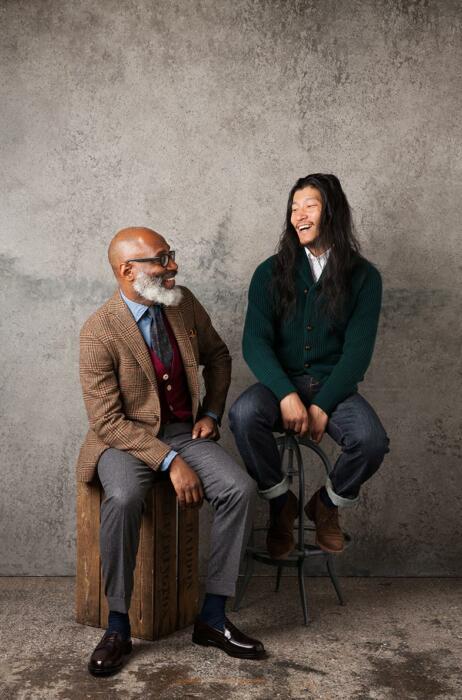
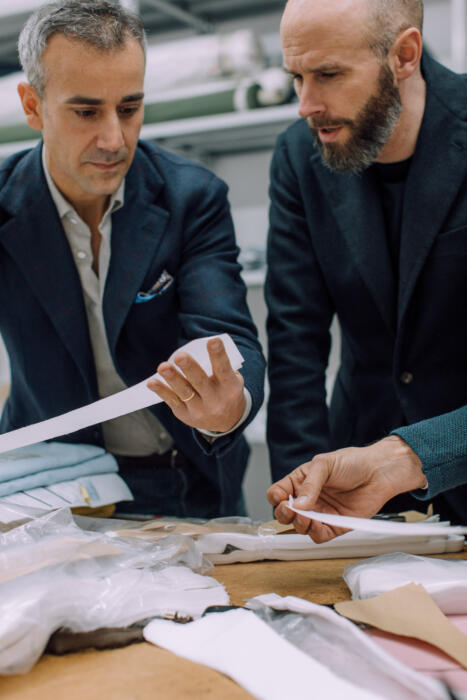
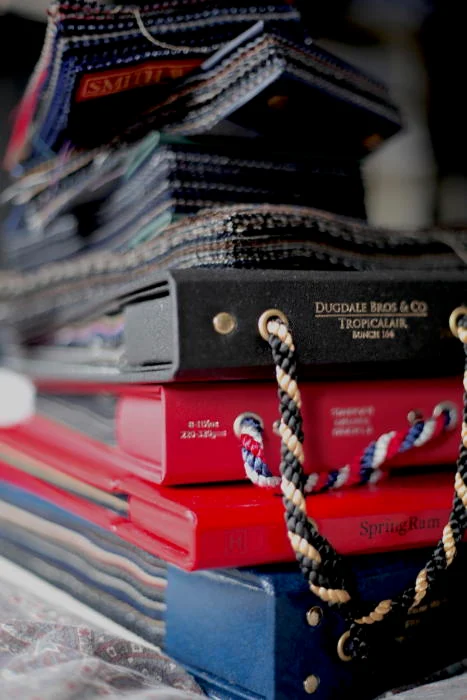
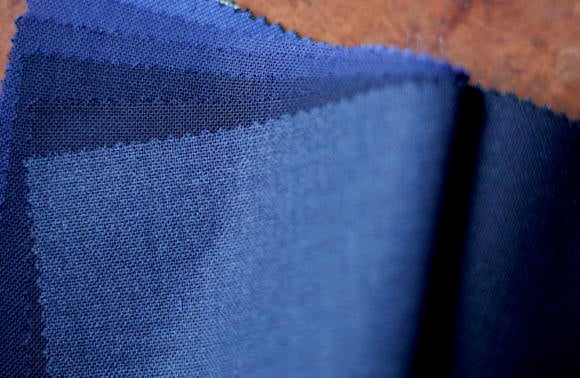
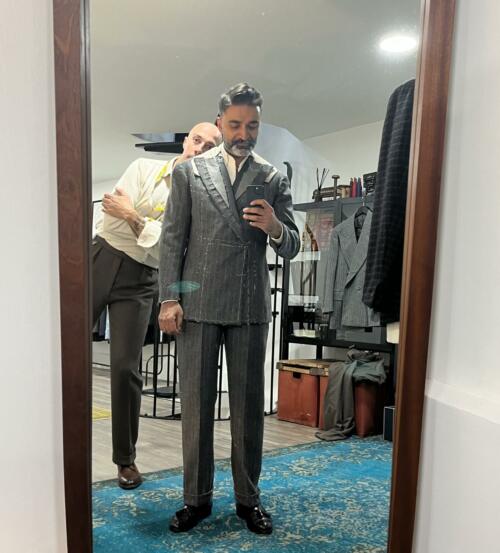
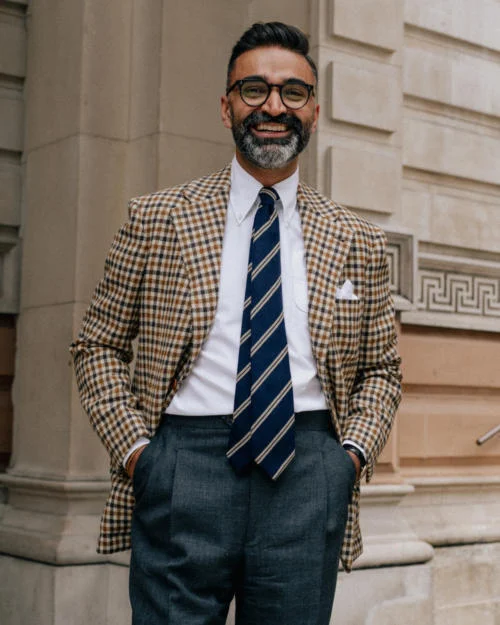
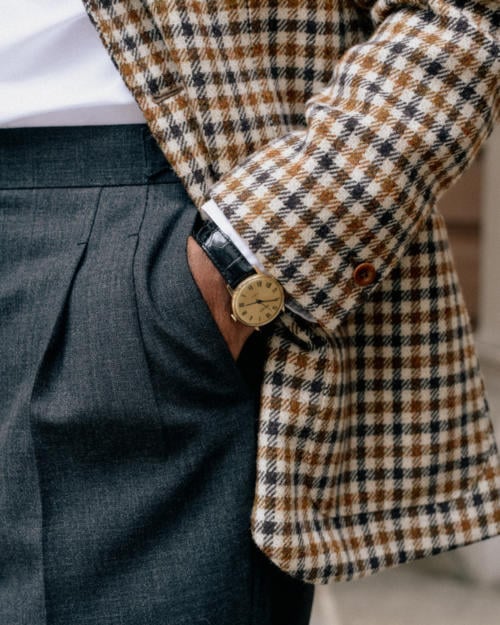
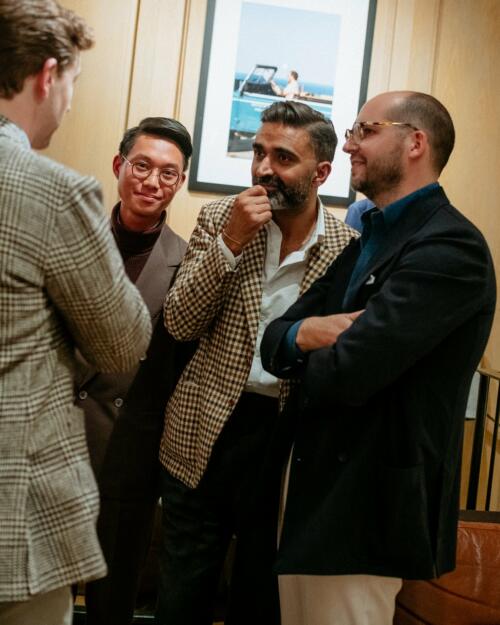


























That’s the kind of gunclub cloth I’d like to commission a jacket from one day. Larger pattern.
Is that not called Shepherd Check?
I could be wrong.
That Fox bunch is absolutely beautiful. I have some samples of cloth from that Tweed bunch.
I’d maybe consider Sartoria Corcos for the gunclub jacket. His style is distinctive, particularly the lapels.
Hi Lindsay
Agreed on the bunch and Corcos would be a wonderful choice!
You may be right on the definition! I think a Gun Club has two or more colours so I guess it depends if you see the check lines as two shades of brown or two distinct colours. However, Fox list it as a Gun Club and who am I to argue with them 🙂
Have a great weekend!
Great to hear from you Manish!
Many thanks for your kind comments.
The last point is a good point manish. I never thougt about it this way. But you’re right. The jackets and suits I wear the least (appart from my tuxedo) are those staple-basics in navy.
Great advice, Manish. A comment and a question.
In my search for a second tailor (in no small part, because my wife assented), I’ve decided to purchase three sport coats this year from different tailors. I went in with an open mind and left with three choices I probably wouldn’t have made a decade ago.
I am curious about your comment on cloth weight. I live in the US South, which is best friends with humidity eleven months a year (they seem to break up every January—typical teenager relationship). I’ve been reluctant to consider anything other than summer weights. In your view, is that an error?
Haha! I like the idea of weather as teen relationship.
I think, in your case, sticking with those summer weights does make total sense to be honest. Hopefully what you lose in not being able to select from as many cloths you gain in trying different tailors, cuts and summery colours.
Dear Manish,
Great timing on your article! After much deliberation, I managed to select a tailor for a first commission on a sports coat. As if that wasn’t hard enough, the next challenge is choosing the cloth… As you said, a navy blue may be a safe choice, but maybe too safe. The other option I like and have been looking at for quite some time, is the gun club check. So you see why your article is well-timed for me and my journey. I agree it is best to go for what really appeals to you. Maybe that would be better stated as playing safe.
The only thing now is the stress of finding the right gun club and hoping it can be found in the limited time at my tailors. But this definitely is a luxury problem if ever there was one.
I think that bespoke gives you the opportunity to create something extra that you really want but is hard to find. At the same time its wise to spend the most money on the things that you use the most, like the winter overcoat and the navy sport coat, not on the pink glenurquhart three-piece or the belted hunting jacket.
Thanks very much, PK.
I’m glad the article was timely for you. There’s lots of terrific options out there to chose from! I’d certainly recommend the Fox Tweed Gun Clubs.
Wishing you the best with your commission!
Thank you Manish! Sure I’ll find something.
All sound advice. I find the last one is particularly important to remember. If you are spending a significant amount of money on a commission, it should be something that speaks to you. Of course it’s good to proceed with caution to avoid getting something so outlandish that you never wear it, but there’s no point just getting something just because menswear bloggers that write cookie cutter articles about “10 must have wardrobe pieces” (one reason I like PS is that Simon doesn’t write those) will approve.
One of my favourite made to order purchases was a dark burgundy jacket with a navy undertone. It’s the last thing any menswear writer would suggest getting and I waited half a year before ordering it. I’m glad I did though because I like it as a statement piece and have found it surprisingly versatile.
Lovely to hear, Alan 🙂 Your jacket sounds great!
Yes, true Alan. I think when people talk about jackets to start with, they’re emphasising versatility, and trying to cover a wide range of different people’s styles. But that might not incorporate yours. The useful thing is to understand why those cloths are being recommended, and whether that then applies to your situation. A young guy into his fashion is very different from a corporate office worker, is very different from a 70-year-old dandy
Thank you Manish! I enjoy wearing it, which is ultimately the most important thing. Occasionally I get complimented on it, which is a nice bonus.
Simon – I agree and think it’s definitely important to think about versatility, but it has to be balanced against buying things that you enjoy wearing (of course there’s also room for a bit of both). I feel that “must have” articles miss that point, whereas your wardrobe building series feels more like friendly advice and encouragement for people to make their own informed choices rather than telling them what they should buy.
Nicely put Alan, and pleased it comes across that way
“…virtually all of us will order something that we hope will make us look like Pierce Brosnan and wind up looking like Piers Morgan.” 😉
Another great write up by Manish.
I’ve often been annoyed with the fact different fabrics affects the fit so much. Linen always feel tighter and catches on the legs where wool flows freely etc, same thing with linen shirts vs oxford etc. Almost to the point I’ve found it best to size up for some fabrics.
Thanks very much, JB! Yeah, I do know exactly what you mean.
Not in the market for cloth or bespoke clothing, but a hilarious and entertaining read as usual. You should write for TV. Thanks Manish
Haha! Cheers Zeke! From your lips to Netflix’s ears!
My first commission of a shirt, to me at least, was simple… it was going to be for work/smart events so a basic white or pale blue and plenty more followed. Relatively they are cheap and so if one doesn’t work out it’s annoying but ok.
Having commissioned 6 suits/jackets I still hate fabric selection. It’s expensive, I cannot afford to get it wrong. I struggle from the small swatch to see the colour (not helped with colour blindness), if it will suit me, will be the level of formality I’m aiming at etc. Of my 6 I would say only 1 was I truly happy with and that was a simple navy twill (which the moths got during Covid). A tweed jacket I love but is too country, a tobacco linen one just doesn’t suit my complexion, my navy hopsack was more formal than I wanted, a mid grey had a brown cast that I hadn’t noted and just don’t love the other navy suit.
Some of these have been fabrics recommended here so simply copying others doesn’t always work either. If someone launched a fabric selection service I’d immediately be in the queue
Personally Bob, I think by far the safest thing is going off materials you’ve seen made up. Never lose an opportunity during a fitting to see what else is hanging up!
If its any consolation Bob, objectively speaking you are better dressed that 90%+ of men on earth with 6 suits/jackets that are not the ideal shade.
Do you have any local tailors who have what you define as good taste? Good starting point.
There is so much here I can relate to LOL .
Manish’s sense of humour in these matters shines through .
The tight weave of a fabric effecting fit is a big takeaway . Rarely is the initial commission faultless and trying to pin down what went ‘wrong’ encourages continues the journey to the next commission .
I think a big lesson I appreciated from having used Simone Abbarachi was that he was there to REALLY help and guide . It was not like a normal menswear store where the salesmen is just after a sale .
It pays to listen to your tailor / shirt maker the first few commissions.
Good point Robin. It makes a huge difference when it’s someone you can talk to, and someone whose opinion you trust – either because he obviously has style, or because he’s guided you well in the past
“Rarely is the initial commission faultless and trying to pin down what went ‘wrong’ encourages continues the journey to the next commission .”
Exactly what tailors are thinking about their work.
Hi Manish, i take your point about the relative importance of weight of fabric to comfort when looking at Autumn/Winter jackets. As you say, the other layers will have more bearing on temperature and comfort than a couple of oz either way. But what is your view on Spring/Summer fabrics? Assuming you only have 2 layers (shirt and jacket), then i would assume the weight of fabric is an important consideration, no?
Hi James
It’s definitely a key factor to think about for the summer but there are other things too.
Using A/W as an example again, I have a 13/14 oz tweed that definitely ‘wears warmer’ than a 15/16 oz tweed and I think it’s because of the tightness of the weave.
Cut is a factor too. My lightest Suitsupply suits were never light enough because I’d always have them too slim! It’s one of the reason’s why Aleks’s Air Jacket from Whitcomb & Shaftesbury works successfully in hotter climes than London: https://www.permanentstyle.com/2024/02/my-case-for-the-lightweight-english-jacket.html
Hope that helps 🙂
Building on this, weave is often more important than weight. Flannels wear warm because the brushed fabric isolates well, while open weaves can be quite cool to wear even in warmer weather, especially if there’s some wind. I have 450g basketweave trousers that I happily wear in the summer – I would probably overheat in 300g flannel trousers. And Irish linnen is known to be quite cool even though it can be remarkably heavy.
Very helpful Manish, thanks for getting back to me.
Great article. Appr when will we get an article about upcoming PS shop releases during the Spring season?
Should be end of next week Carl
Forget the advise and the bespoke commissions, we should follow your music choice. 😊😇
Haha! Thanks for clicking the links AKG! 🙂
Hi, In the last picture (4 lads in discussion), the gentleman way on the left, does anybody know what cloth that could be? Am having problems sourcing something like it. Thx JR
Hi JR
That’s David from the PS Reader Profile series: https://www.permanentstyle.com/2021/09/reader-profile-david.html
I’ll give him a nudge and see if he can advise!
Thanks JR. I think that might be me in the photo. The jacket is by Prologue in a Marling & Evans undyed wool. I can’t find the fabric code but I believe it’s the same cloth and maker as Simon is wearing here:
https://www.permanentstyle.com/2020/05/introducing-the-finest-cardigan.html
Hope that helps!
Extremely helpful thx everybody for the input!
A great article by Manish! Regarding everyone having their own personal notion of “the perfect blue” – I remember being told off by my partner years ago because I rejected over a dozen shades of dark blue tile (for a kitchen splashback) for being “the wrong shade of blue”. My second bespoke commission was a navy DB blazer; it took well over an hour and trawling the tailor’s archives to find just the right shade of navy in just the right fabric: Scabal Galaxy 705674. I knew exactly what I was looking for… just needed to find it.
Then I went mad and had it lined with a very dark red/black paisley. What can I say? It called to me! But the result is my favourite piece of clothing – I love it to bits.
Wonderful, Paul! And thanks for sharing the ref too! I know PS readers always appreciate the specifics.
Great article Manish and I love your signature look. I had a similar gun check made with my local tailor in Fox Bros flannel. I was horrified when I went to wear it, mostly because it was not ‘basic blue’ and it was outside my comfort zone. But I overcame the feeling and I wore it!
I am happy to say that after a few wears I found myself gravitating to it more and more and I feel great in it! It fetches compliments as well.
For those of you with ‘mistakes’ in your closets, go ahead and wear them. You might be pleasantly surprised!
Thanks so much, DrBruno! What a fantastic ‘mistake’!
The last section is as well written and enjoyable as anything ever on this site. And so true. When I follow inspiration I get something I really like, and it gets worn far more than safer, more versatile choices. One of the greatest things about bespoke is that you can get something nobody else has, something a bit different.
Thank you so much, Rogey!
Here’s to following one’s inspiration 🙂
Manish, you’ve definitely got a novel in you. Give it a try! Very slightly off topic. I’ve been seriously considering commissioning a suit for a while now but have one major concern, that I may well be ‘over thinking’. I’m a slim 6ft/12 stone, with a 42 in chest and 32 in waist. Now, when I say good, I mean I’ve been well disciplined at the gym! Now I’m recovering from a recent hernia op and I’m afraid I’m 11,7lbs with a rather puny 40in chest but a 33in waist! Quite apart from this recent episode, my weight does fluctuate. So tell me, would I be wasting my money, aiming for the ‘fits like a glove’ objective if my weight and proportions are prone to such variations?
I wouldn’t say so Richard, assuming that this recent fluctuation is not normal given the operation. But I would err away from those ideas of close fit, as that will mean any weight gain will immediately make the suit unwearable
Interested to read more about your take on overheating. For reference, last 3 years I was never uncomfortably cold in zipped up Vax walker with a chunky scarf over thin cotton jumper. Pretty comfy unzipped if liner is in. I think part of the problem is I have habit of walking so fast that smart watch thinks it’s a fat burning cardio..
What works for me is heavier jackets but think about them as outerwear… But when it’s summer, I’ve found only 2 things that sort of work. Completely unlined and unstructured so light hopsack that even doubled up is transparent and PS linen over shirt ..
Manish,
When would you say a person has crossed over into having a problem and has officially joined AA, Attire Anonymous? Or what are the early symptoms?
-has more than once had to convince the alterationist that a a quarter inch at the bottom of the jacket is worth it?
-storing fabric for more than two years while looking for the right tailor with a style that matches the fabric?
-has had their wife ask to help pick out her outfit for the evening?
-has ever thought “rounding out” the staples as owning a navy polo with every iteration of collar, hem, and sleeve cuff?
Etc.
-has ever muttered the phrase, “I just can’t find anyone who makes it”
-or has ever asked in the comments section if Simon is ever going to make a summer knit long sleeve polo with ribbed cuffs and hem because some of us need to avoid definition around the waist but would still like to look elegant in the humid summer months?
Just some random examples.
Haha! Thank you Caleb C. for these great “random” examples. I look forward to seeing you at our next meeting 🙂
Very nice writing – I appreciate the verve (and the constant asides in parentheses, which I tend to use often, myself).
My one foray into custom, I wanted an OCBD but the maker only had a dressier material in 100% cotton (I had a gift card to use so I was stuck with them) – the lesson of getting something that you actually want to wear (and enjoy wearing) is primordial.
This is a great article and covers very well why I think I’m reasonable to have reservations about going bespoke!
My solution is likely to be – trust the tailor and go obvious/boring or see something I like and outrageously plagiarise.
Question is – what item to start with?
For my two cents CJ, I’d say look at our top five jackets piece, but ignore the order, pick the one that you think best suits your lifestyle/needs. As Manish says, it may well not be a navy
Thank you Simon, appreciate the recommendation.
Hey Simon,
Do you know any finishers in london who do hand buttonholes?
Hi Rhys,
So, all finishers would do hand-sewn buttonholes. The issue is most of them don’t really work for end customers, just for tailors. Your best bet would be to approach one of the better alterations places, as we recommend here, and ask them if they can do a hand-sewn buttonhole.
Although can I ask, are you trying to take out a machine buttonhole and replace it with a hand-sewn one? That doesn’t usually work so well, as the machine buttonhole has already sewn into the material around the hole.
Yes – I have to change a buttonholes colour. Do you have any companies you recommend?
Hey Rhys – sorry ‘here’ was meant to be hyperlinked in my comment, to this page. Have a look there
These articles from Manish are an absolute delight. Full of knowledge, insight and wonderful humour. They crack me up every time.
Thanks so much, Bobby S! I really appreciate it!
Hey Manish,
While I understand your perspective, I believe there’s an excessive amount of drama surrounding this issue. Come on, it’s just a piece of cloth meant to boost your self-confidence, not define you as a person.
Putting so much thought and hope into whether a jacket or suit will elevate you as an individual seems unnecessary. I know it’s part of the game in menswear, but let’s not be ridiculous.
This artificial environment caters to culturally impoverished individuals aiming to enhance themselves solely through dressing better and gaining recognition through bespoke or cultivating “personal style.”
I think there’s too much overthinking involved. If you’re hesitant about investing in bespoke and find yourself saying, “it’s a lot of money, so I need to choose carefully,” then perhaps bespoke isn’t the right choice for you. It’s as simple as that. You won’t suddenly feel like James Bond, and in the long run, people’s perceptions of you won’t drastically change. I speak from experience, owning several bespoke garments, including about a dozen navy blazers…
Take it easy, man!
Cheers Enry.
Easy tiger! I’m pretty confident my perspective has never extended so far as to think clothes define you as a person. Perhaps that’s just your perspective of my perspective?
Otherwise, sound advice all round.
Take it easy, yourself!
It is entirely possible, Manish, and I trust you will not misconstrue my intentions or respond defensively. I apologize if my words convey such a tone, but I am deeply influenced by the atmosphere of the menswear world, where there is often an overemphasis on superficiality, ultimately detracting from the richness of our interactions. The shallowness is remarkable and advantageous when not excessively interpreted.
It is important to recognize that there is often a subconscious inclination to present ourselves as more refined or sophisticated than we truly feel, a concept that Jung identified long before it gained widespread recognition.
As an author, it is imperative to remain open to diverse perspectives, maintain emotional composure, and exhibit forgiveness. While I understand that writing may not be your primary focus, it remains a significant aspect of our reality. I do not disparage your storytelling or writing style.
I will return now in my position, but if I should happen to encounter you (as I occasionally attend menswear aficionado meetups around the globe), I will introduce myself. And I hope, at least in that context, you will forgive me if I choose something more restrained and healthful than a Negroni.
Wishing you a pleasant remainder of your day.
“[If] find yourself saying, “it’s a lot of money, so I need to choose carefully,” then perhaps bespoke isn’t the right choice for you.”
There is a regrettable assumption I have seen a number of times on the comments in this website, that if you need to choose carefully then bespoke may not be for you. Not being wasteful is an admirable quality regardless of how great your resources are.
Thank you, Alex, for your response.
I wholeheartedly agree. Each person establishes their own boundaries and perceives their wealth differently, often indulging in luxury pleasures, such as bespoke items. Consider, for example, a billionaire I know who primarily wears Uniqlo clothing.
Bespoke isn’t solely about displaying wealth; it also reflects one’s willingness to take risks. Even if someone earns a modest income of $1,000 a month, they can still save for bespoke items. While some may find this notion embarrassing, I am liberal-minded, believing in pursuing what brings personal satisfaction while also respecting others and the environment.
However, embarking on the bespoke journey with limited funds can be challenging and demands discipline, which I admittedly lack. It can be a lengthy process, especially when working with entry-level tailors.
The first bespoke experience isn’t likely to involve renowned names like Liverano or Michael Browne; instead, this guy may require more a personal finance lesson, lol. The outcome may be exceptional right from the start, or it may take time to achieve the desired result, particularly with modest means.
When I couldn’t afford it, I didn’t strive for it. Now, if I can commission a couple of suits per year, I do so. In the future, if I find myself unable to continue, it won’t bother me. Sometimes we try to hard, that’s not for me at this stage of my life.
I agree that this notion is far excessive. If that was true, only filthy rich VIPs, CEOs and politicians should be expected to buy bespoke.
Of course, if making a mistake is financial ruin, then it’s best not to commission (but then it probably applies whether the piece works or not), but if the consequence of a mistake is, e.g., “I can’t afford to get a replacement bespoke piece until the end of next year”, that would be pretty common for a lot of very reasonable new and veteran bespoke clients alike, I’m sure.
A very interesting article. It mirrors exactly some of my experiences. I completely agree about swatches – I have a bag full of them.
My first few commissions were unremarkable and almost all great successes – mostly because they were very very boring. When things got more interesting they quickly went wrong. Most notably with a vivid green tweed with lillacy purple overcheck tweed jacket. A total disaster, and an expensive mistake. People actually laughed.
Now, whenever possible, and always with tweeds, I buy a suitable length of fabric and live with it for as long as possible. If it still excites months or even years later it gets made up. It has saved me several more costly mistakes, and if you do decide against the fabric it can almost always be sold on.
Unusual evening wear is particullarly troublesome – i.e. the perfect tartan fabric (for trousers, trews or jacket) when viewed in the daytime can disappear to a sludgy almost uniform grey at night. Similarly a tonally perfect tartan when dimly or candle-lit is likely to be garish during the day.
My best advice; live with the cloth, and always take your time with the unusual.
Interesting, thanks Tim
Hi Manish,
Thanks for this instructive post! Always enjoyable to read you too!
Now to my point, which is related to the fabrics used for navy blazers. As you know, when it comes to the relevant wool fabrics, at one end of the spectrum, we have mesh, perhaps, for SS and at the other,for AW, a heavy hopsack version, pimarily from England, among others.
Surprsingly enough, the later seems to have disappeared from the menswear, let alone as cloth for RTW blazers. Whereas in the past, Houses such as Gives & Hawkes, Ede & Ravenscroft, among others, had consistenly offered them in their RTW collections.
In your post, you’ve suggested “lambswool twill for Winter”. But don’t you think that under certain conditions, the aformentionned hopsack could be even more useful?
John
,
This is one of the funniest written articles. You have a gift. Thank you!
Manish
I appreciate the humor and insight of your articles. I too have felt the tension and terror of lookbooks, and I also rate them . No matter how careful I have been in selecting swatches, I also occasionally have been defeated and wrong in my selections. I then can ruminate for months about why I made such choices, and blame the gods, the planets, the weather, my diet, and bad luck.
I’m still certain my last coat swatch was light blue, but the coat is darker…
Great article.
In most instances, instead of going lighter in cloth, go more breathable, a less dense weave.
My personal bias is also to harder, dryer finishes. Newbies might be tempted by something soft but it can age badly.
Also think about the cloth – cut interaction. A refined cut ( one button, long peaked lapel ) needs a refined cloth. Somet rougher / more rustic cloth may need a boxier, 3 button roll 2 style.
“I would be so much cooler if I just went for that 12oz flannel trouser”
Hey Manish. Have you looked at Holland and Sherry‘s heavy flannels? They are a notch heavier than Heritage Flannel and I was wondering about their wearability. Would the cloth not look bulky against my shoes? Is it like wearing an overcoat inside? So far my bespoke commissions were summer suits only.
I’m not sure which thread would be most appropriate to ask this, so hope this is ok.
My wife has an overcoat made by a good tailor in London (covered by you before, Simon). She has lost a significant amount of weight recently – around 20% of her body weight – and the coat no longer has the shape it use to. It was collected from the tailor one and a half years ago.
We will ask the tailor to alter it, but I am wondering what to expect in terms of whether the tailor would do this for free, or whether we should expect to pay. I was also wondering about this in general terms, of whether one should expect free alteration from the original tailor with changing body weight/shape, or whether that is an unreasonable expectation. And over what time frame would it be reasonable to expect free alteration.
I am assuming it’s a case of ask and see what they say, but it would be good to know if there is a general rule of thumb here.
Thank you!
So, the rule of thumb used to be that alterations were done for free on long-term customers. Because those customers were always ordering new things at the same time, or had spent a lot of money over the years.
These days, so many people order just one piece that this doesn’t really work. So tailors usually charge, and I think that’s reasonable. Just making one piece is so much more expensive for them than making multiple ones.
We talked about this a bit on this article.
Many thanks Simon. It certainly makes sense to return the garment to the original maker for alterations, even if additional cost is incurred.
Thanks again
No problem John